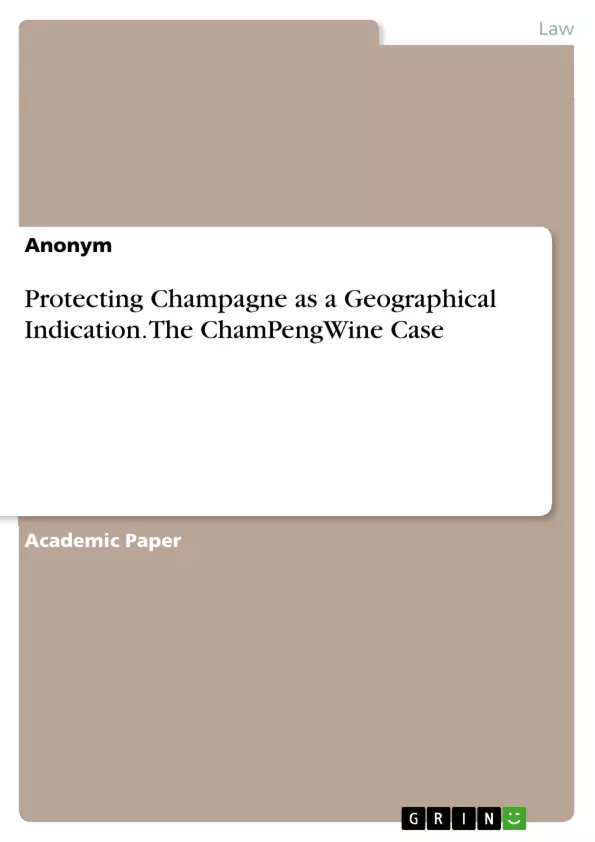This paper aims to explore the interplay between trademark law and the often-elusive concept of bad faith against the backdrop of protecting the Champagne Geographical Indication by examining the case of CIVC and INAO v. Keep Waddling International Pte. Ltd. [2020] SGIPOS 10 and its implications within trademark and GI jurisprudence.
The unique reputation of champagne is guaranteed by the protection afforded by the Champagne GI, a type of intellectual property right primarily cited in the Agreement on Trade-Related Aspects of Intellectual Property Rights (TRIPS), ensuring that the label champagne can only be used for sparkling wines produced from certain grape varieties grown in the eponymous region in France. Protecting the appellation of origin reassures the consumer product authenticity and the strict restraints on the words use by the CIVC and INAO is motivated by the anticipation of the term and therefore the product of champagne becoming arbitrary and universal with unlimited use.
The degree of similarity of terms and the therefore resulting likelihood of confusion for the consumer plays an essential role in deciding whether signs for products manufactured outside the Champagne region can be granted legal protection or not. In the case considered, the inclusion of "ChamPeng" in the Applicant’s trademark led to the refusal of its protection, not because the trademark would not meet the necessary registration requirements, but because its similarity to the champagne term gave inference for bad faith. Since the case’s dispute does not arise from a false claim or deceptive information, it particularly diverges from traditionally established bad faith categories. Therefore, the following question arises: How does the case contribute to the conduct of protection of GIs in trademark law?
The examination of the aforementioned issue will involve a comprehensive review of the case under consideration. Initially, the legal foundations and the Applicant's claims that prompted the legal proceedings will be outlined to establish the legal basis of the case. Subsequently, attention will be directed towards presenting the counterpart’s position, providing insights into the potential resolution of the dispute afterwards. Finally, the Court's ultimate decision will be scrutinized to discern its potential impact on enhancing the broader legal framework and in its challenging of conventional boundaries within trademark jurisprudence.
Table of Contents
- Introduction
- CIVC and INAO v. Keep Waddling International Pte. Ltd.: Introduction to the case and plaintiff's position
- CIVC and INAO v. Keep Waddling International Pte. Ltd.: The defendants' position
- CIVC and INAO v. Keep Waddling International Pte. Ltd.: Motives backing court's final decision
- Conclusion
Objectives and Key Themes
This essay examines the case of Comité Interprofessionnel du Vin de Champagne (CIVC) and Institut National de l'Origine et de la Qualité (INAO) v. Keep Waddling International Pte. Ltd. to explore the interaction between trademark law and the concept of bad faith in protecting the Champagne Geographical Indication (GI). It analyzes the legal proceedings and the court's decision, specifically focusing on the implications for trademark and GI jurisprudence.
- The protection of the Champagne GI and its significance in international trade.
- The interplay between trademark law and the concept of bad faith.
- The role of similarity in trademark disputes and the potential for consumer confusion.
- The application of legal frameworks, such as the Paris Convention and the Agreement on Trade-Related Aspects of Intellectual Property Rights (TRIPS), in trademark disputes.
- The implications of the ChamPengWine case for the broader legal framework and conventional boundaries within trademark jurisprudence.
Chapter Summaries
- Introduction: This chapter sets the stage for the case by introducing the Champagne GI, its importance, and the challenges posed by economic players seeking to profit from its reputation. It highlights the unique aspects of the ChamPengWine case and poses the central question: How does this case contribute to the protection of GIs in trademark law? The limitations of the analysis are also discussed.
- CIVC and INAO v. Keep Waddling International Pte. Ltd.: Introduction to the case and plaintiff's position: This chapter outlines the legal action initiated by CIVC and INAO against Keep Waddling's trademark application for "ChamPengWine" for sparkling wines originating from Chile. It discusses the international implications of the case, the jurisdiction involved, and the legal basis for the proceedings in Singapore.
- CIVC and INAO v. Keep Waddling International Pte. Ltd.: The defendants' position: This chapter presents the defendants' arguments, highlighting their claim that their trademark does not deceive the public and does not violate the applicable laws protecting GIs. The chapter also explores the legal grounds of opposition raised by the plaintiffs.
Keywords
This essay focuses on the intersection of trademark law and geographical indications (GIs) in the context of the ChamPengWine case. Key themes include bad faith, consumer confusion, trademark registration, the protection of GIs, international trademark law, the Paris Convention, and the Agreement on Trade-Related Aspects of Intellectual Property Rights (TRIPS).
- Quote paper
- Anonym (Author), 2024, Protecting Champagne as a Geographical Indication. The ChamPengWine Case, Munich, GRIN Verlag, https://www.hausarbeiten.de/document/1494669


